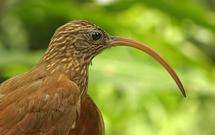Beaks show why 'sister' species don't live together

(Phys.org)—A study of closely-related bird species has found that they do not coexist in the same region because they remain too ecologically similar and will out-compete each other, not because of geographical barriers or unsuitable habitats.
Oxford University scientists examined 'sister' species – species that are each other's closest relatives – of the 'ovenbird' family from South America. They compared data on when these species diverged and where they live today and found that those that have been separated for longest and have evolved very different beaks were able to coexist more rapidly after they became two separate species.
The findings suggest that species displaced due to climate change may not be able to survive in what appears to be a suitable new habitat because a related species already living there will out-compete them for resources.
A report of the research appears this week in Ecology Letters.
'Competitive exclusion between species is generally thought to be limited to relatively small spatial scales, such as between individual birds or across local patches of habitat,' said Dr Alex Pigot of Oxford University's Department of Zoology, lead author of the report. 'In our work we are able to show that competition is a major factor responsible for excluding closely-related species from entire regions. The key was being able to rule out other explanations like geographical barriers, such as rivers, or unsuitable habitats from being the main barriers to 'sister' species co-existing.'
'Ovenbirds' (Furnariidae), so called because in some species their domed nests resemble a traditional Dutch oven, are found throughout South America; there are hundreds of species inhabiting a range of environments from deserts and grasslands to tropical forests. The Oxford team chose to study them because their very diverse beaks give useful information on how related species have evolved to fill particular ecological niches.
'The beak is the main tool used by birds for capturing and consuming food items and so has been moulded by natural selection to fit this purpose,' said Dr Pigot. 'In ovenbirds some species have evolved bizarrely long curved bills in order to prise insects from bamboo stems or beneath the bark of trees, but only one such species tends to live in any given place. Our results suggest that it can take a long time to evolve a foraging niche different enough to allow coexistence amongst related species.'
As environments become hotter or drier, for instance due to climate change, it has been generally assumed that species will track suitable conditions and move to new locations. This new research shows that the area of suitable habitats could be much smaller than current estimates suggest, as many regions will already be occupied by related species that will out-compete any newcomers. This implies that the full impact of environmental change cannot be understood without considering competitive interactions between species.
More information: Pigot, A. and Tobias, J. Species interactions constrain geographical range expansion over evolutionary time, Ecology Letters.
Journal information: Ecology Letters
Provided by Oxford University

















